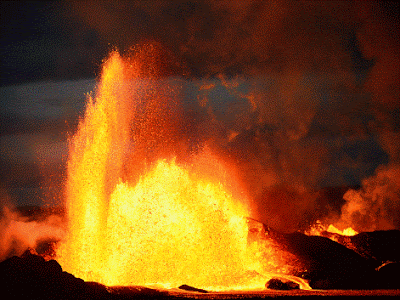Redoubt Volcano on March 31, 2009. View to the east of the summit crater of the volcano, heavily covered with deposits from recent eruptions, many of which were preceded by harmonic tremor.
Credit: Game McGimsey
It is not unusual for swarms of small earthquakes to precede a volcanic eruption.
They can reach a point of such rapid succession that they create a signal called harmonic tremor that resembles sound made by various types of musical instruments, though at frequencies much lower than humans can hear.
A new analysis of an eruption sequence at
Alaska's Redoubt Volcano in March 2009 shows that the harmonic tremor glided to substantially higher frequencies and then stopped abruptly just before six of the eruptions, five of them coming in succession.
"The frequency of this tremor is unusually high for a volcano, and it's not easily explained by many of the accepted theories," said
Alicia Hotovec-Ellis, a
University of Washington doctoral student in Earth and space sciences.
Documenting the activity gives clues to a volcano's pressurization right before an explosion.
That could help refine models and allow scientists to better understand what happens during eruptive cycles in volcanoes like Redoubt, she said.
The source of the earthquakes and harmonic tremor isn't known precisely. Some volcanoes emit sound when magma – a mixture of molten rock, suspended solids and gas bubbles – resonates as it pushes up through thin cracks in the Earth's crust.
But Hotovec-Ellis believes in this case the earthquakes and harmonic tremor happen as magma is forced through a narrow conduit under great pressure into the heart of the mountain.
The thick magma sticks to the rock surface inside the conduit until the pressure is enough to move it higher, where it sticks until the pressure moves it again.
Each of these sudden movements results in a small earthquake, ranging in magnitude from about 0.5 to 1.5, she said. As the pressure builds, the quakes get smaller and happen in such rapid succession that they blend into a continuous harmonic tremor.
"Because there's less time between each earthquake, there's not enough time to build up enough pressure for a bigger one," Hotovec-Ellis said. "After the frequency glides up to a ridiculously high frequency, it pauses and then it explodes."
She is the lead author of a forthcoming paper in the
Journal of Volcanology and Geothermal Research that describes the research. Co-authors are
John Vidale of the UW and
Stephanie Prejean and
Joan Gomberg of the U.S. Geological Survey.
The pause in the harmonic tremor frequency increase just before the volcanic explosion is the main focus of the
Nature Geoscience paper.
"We think the pause is when even the earthquakes can't keep up anymore and the two sides of the fault slide smoothly against each other," Hotovec-Ellis said.
Upward-gliding tremor immediately before a volcanic explosion also has been documented at the
Arenal Volcano in Costa Rica and
Soufrière Hills volcano on the Caribbean island of Montserrat.
"Redoubt is unique in that it is much clearer that that is what's going on," Hotovec-Ellis said. "I think the next step is understanding why the stresses are so high."
More information: Paper:
DOI: 10.1038/ngeo1879









































